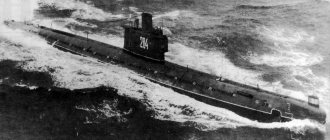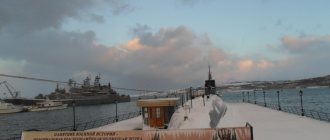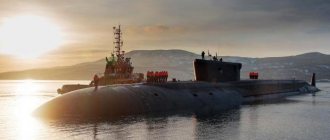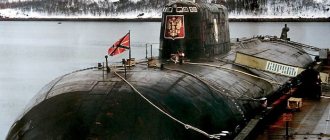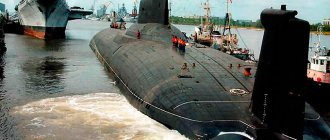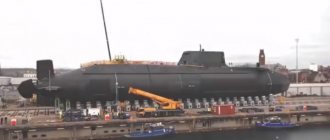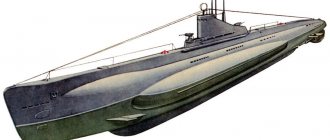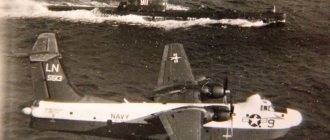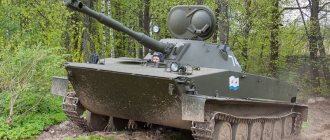History scrapped: the insides of a Project 641 submarine
Would you like to visit a real submarine? We think the answer will be positive. We are sure that you know the final mooring addresses of museum submarines scattered throughout different cities of Russia; there are currently eight of them in our country:
- Submarine S-189 (St. Petersburg);
- Submarine D-2 “Narodovolets” (St. Petersburg);
- Submarine K-21 (Murmansk);
- Submarine B-413 (Kaliningrad);
- Submarine B-396 “Novosibirsk Komsomolets” (Moscow);
- Submarine S-56 (Vladivostok);
- Submarine B-307 (Tolyatti);
- Submarine M-261 (Krasnodar).
But when visiting some of these submarines, a tourist may encounter a number of discrepancies with reality. Thus, not all the exhibited submarines are authentic - for example, to please visitors with limited mobility, some of these boats have widened the openings and removed part of the bulkheads between the compartments, changed the interior and removed some equipment for more convenient accommodation of excursion groups and museum exhibits.
The end result is interesting, but not very realistic. Some note of originality, some barely perceptible breath of history is gone.
And so we found a story about an understaffed, living out its last days (it had already been scrapped), but still somewhat more realistic submarine, which began its career in 1965, served in the Northern Fleet, in the waters of the Baltic and the Mediterranean Sea and for several years was even based in Egypt.
Lovers of abandoned buildings visited it and took 15 photographs. 15 pictures of a Soviet submarine that has already become history, legendary history! Let's walk through the compartments and find out a little more about the submarine...
Project 641 submarines
Intercompartment bulkhead of a submarine
Project 641 submarines are a series of Soviet diesel-electric submarines (DES), according to NATO classification - Foxtrot. The project was considered successful. The submarines were designed for long-distance passages and ocean patrols, equipped with the latest torpedo tubes at that time.
75 ships were built, including 17 submarines that were exported to the navies of Poland, India, Libya and Cuba.
The first submarine of Project 641, in the creation of which one of the legendary chief designers and shipbuilders Zosim Aleksandrovich Deribin took part, entered the Soviet fleet in 1958.
The project became obsolete only with the beginning of the massive arrival of nuclear submarines. The last submarine of the project was delivered in 1983. With the advent of nuclear-powered ships without restrictions on range and partly on patrol time, Project 641 moved into the category of short-range boats.
The crew consisted of 70 people, and the navigation autonomy was limited to 90 days. Today, especially in comparison with the gigantic nuclear submarines of the Russian Navy, it seems like an extremely small submarine, on which it seemed an extremely difficult task to maintain a combat watch.
Of course, this is a fact, because the much more modern nuclear submarine "Borey" Project 955 for 107 crew members has 24 thousand tons of displacement, 170 meters in length and 13.5 meters in width , while the diesel-electric submarine Project 641 has these indicators, which means and the internal usable space for the crew is much more modest:
- length 91.3 meters ;
- width 7.4 meters ;
- displacement 2,475 tons
Torpedo compartment
After going to the stern of the submarine, you can go down into the empty compartment with four torpedo tubes (7th compartment of the submarine).
Electric motor compartment and diesel engine
After passing through a narrow passage, dotted with many instruments, buttons and valves, you find yourself in the electric motor compartment, through which you can see the diesel engine - compartments 6 and 5, respectively.
Other compartments, including sonar station and central station
Naturally, the submarine also has a hydroacoustics post, whose combat mission included tracking enemy ships and submarines and other vessels or objects and obstacles.
Through the radio room it was possible to send and receive encrypted messages, and the central post was equipped with radar, sonar and, of course, one of the main symbols of any submarine - a periscope for searching and tracking targets.
Torpedo tubes
Hermetic door between compartments
Central post
Periscope
Team place
Electric generator/engine control
The engine control unit
Chief mechanic's workplace
Nasal compartment
“And now we finally got to the bow compartment. Here we were met by six more torpedo tubes and another dummy torpedo. This submarine was capable of carrying a total of 22 torpedoes, ten of which were in the torpedo tubes, with a further twelve waiting to be loaded into them.
The crew not only kept watch, but also slept here, next to the torpedoes. When the submarine was fully armed, this compartment became as crowded as the rest of the submarine’s compartments.”
Full-size torpedo mockup
Spare torpedo next to the torpedo tubes
Unfortunately, when photographers visited this submarine, part of the hull had already been cut off, there were huge holes in it, and the equipment was partially removed or damaged.
After 30 years of service, it was cut up for scrap. It’s a pity... but someday the legends also need to go down in history, especially since they are replaced by much more powerful, formidable and crew-friendly units.
Latrine
Large submarines Project 641 Project I641 Project I641K
Quantity
75 units
Construction
Project 641 – Leningrad, Shipyard No. 196 (from 10/25/1966 Novo-Admiralteysky Shipyard, from 01/31/1972 “Leningrad Admiralty Association”) – 58 units
Name
| Factory | Pawned | Launched | Commissioning | Note | |
| B-94 | №763 | 3.10.1957 | 28.12.1957 | 25.12.1958 | |
| B-95 | №764 | 2.02.1958 | 25.04.1958 | 30.09.1959 | |
| B-36 | №765 | 29.04.1958 | 31.08.1958 | 30.09.1959 | |
| B-37 | №766 | 18.07.1958 | 5.11.1958 | 5.11.1959 | |
| B-133 | №769 | 27.09.1958 | 26.01.1959 | 5.11.1959 | from 04/20/1970 - B-833 |
| B-135 | №770 | 20.12.1958 | 30.03.1959 | 5.11.1959 | |
| B-139 | №771 | 25.02.1959 | 30.05.1959 | 15.03.1960 | from 04/20/1970 - B-839 |
| B-57 | №777 | 23.04.1959 | 15.08.1959 | 28.07.1960 | |
| B-116 | №778 | 9.06.1959 | 10.10.1959 | 25.08.1960 | from 03.08.1977 - B-326 |
| B-130 | №779 | 22.08.1959 | 17.12.1959 | 22.09.1960 | |
| B-143 | №780 | 21.10.1959 | 17.02.1960 | 5.11.1960 | |
| B-85 | №781 | 23.12.1959 | 19.03.1960 | 23.12.1960 | |
| B-59 | №786 | 21.02.1960 | 6.06.1960 | 10.06.1961 | |
| B-156 | №787 | 20.04.1960 | 2.08.1960 | 18.04.1961 | from 04/20/1970 - B-856 |
| B-4 | №788 | 14.06.1960 | 3.10.1960 | 31.08.1961 | from 01/16/1963 - B-4 Chelyabinsk Komsomolets |
| B-153 | №790 | 6.08.1960 | 31.01.1961 | 30.09.1961 | from 04/20/1970 - B-854 |
| B-164 | №791 | 26.10.1960 | 18.02.1961 | 16.10.1961 | |
| B-33 | №792 | 3.02.1961 | 27.04.1961 | 27.11.1961 | |
| B-7 | №793 | 14.04.1961 | 29.06.1961 | 15.12.1961 | |
| B-105 | №794 | 1.07.1961 | 1.10.1961 | 15.06.1962 | |
| B-169 | №795 | 17.08.1961 | 29.11.1961 | 28.07.1962 | |
| B-38 | №796 | 30.10.1961 | 31.01.1962 | 30.09.1962 | from 04/20/1970 - B-838 |
| B-53 | №797 | 8.01.1962 | 12.04.1962 | 5.11.1962 | from 04/20/1970 - B-853 |
| B-50 | №798 | 7.03.1962 | 15.06.1962 | 8.12.1962 | |
| B-8 | №799 | 9.05.1962 | 21.07.1962 | 18.12.1962 | |
| B-31 | №800 | 18.08.1962 | 3.11.1962 | 25.06.1963 | |
| B-2 | №801 | 27.10.1962 | 25.01.1963 | 14.06.1963 | |
| B-55 | №802 | 22.01.1963 | 5.04.1963 | 20.09.1963 | from 04/20/1970 - B-855 |
| B-98 | №806 | 4.04.1963 | 15.06.1963 | 15.05.1964 | |
| B-101 | №807 | 19.06.1963 | 30.08.1963 | 29.05.1964 | |
| B-6 | №808 | 9.08.1963 | 30.11.1963 | 30.07.1964 | |
| B-15 | №809 | 10.10.1963 | 21.02.1964 | 30.09.1964 | |
| B-103 | №810 | 14.12.1963 | 16.04.1964 | 24.12.1964 | |
| B-109 | №811 | 22.02.1964 | 17.06.1964 | 15.04.1965 | |
| B-107 | №812 | 18.04.1964 | 25.07.1964 | 28.04.1965 | from 04/20/1970 - B-807 |
| B-112 | №813 | 19.06.1964 | 27.10.1964 | 5.08.1965 | |
| B-25 | №814 | 26.08.1964 | 22.12.1964 | 6.09.1965 | from 04/20/1970 - B-825 |
| B-21 | №815 | 29.10.1964 | 16.02.1965 | 31.10.1965 | from 04/20/1970 - B-821, from 04/3/1989 - B-821 Bryansk Komsomolets, from 02/15/1992 - B-821 |
| B-9 | №816 | 26.12.1964 | 31.03.1965 | 30.11.1965 | |
| B-26 | №817 | 6.05.1965 | 10.08.1965 | 24.03.1966 | from 02/15/1965 - B-26 Yaroslavsky Komsomolets, from 04/20/1970 - B-826 Yaroslavsky Komsomolets |
| B-28 | №818 | 24.05.1965 | 10.08.1965 | 18.06.1966 | |
| B-34 | №819 | 13.08.1965 | 16.11.1965 | 31.07.1966 | |
| B-40 | №820 | 24.09.1965 | 16.11.1965 | 6.09.1966 | from 04/20/1970 - B-840 |
| B-29 | №821 | 25.03.1966 | 20.05.1966 | 28.11.1966 | |
| B-41 | №822 | 7.04.1966 | 20.05.1966 | 24.12.1966 | |
| B-46 | №823 | 13.08.1966 | 24.12.1966 | 30.06.1967 | |
| B-49 | №200 | 12.10.1966 | 24.12.1966 | 30.06.1967 | |
| B-39 | №210 | 9.02.1967 | 15.04.1967 | 28.12.1967 | |
| B-397 | №215 | 7.05.1967 | 22.08.1967 | 31.12.1967 | |
| B-400 | №220 | 29.05.1967 | 22.08.1967 | 25.09.1968 | from 12/30/1987 - B-400 Ulyanovsky Komsomolets |
| B-413 | №235 | 28.06.1968 | 7.10.1968 | 25.12.1968 | |
| B-416 | №240 | 18.07.1968 | 25.02.1969 | 4.12.1969 | |
| B-205 | №245 | 17.06.1969 | 29.08.1969 | 28.12.1969 | |
| B-213 | №250 | 1.10.1969 | 20.01.1970 | 4.08.1970 | |
| B-435 | №260 | 24.03.1970 | 29.05.1970 | 6.11.1970 | |
| B-440 | №265 | 1.06.1970 | 16.09.1970 | 25.12.1970 | |
| B-409 | №270 | 18.12.1970 | 2.03.1971 | 10.09.1971 | |
| B-427 | №275 | 10.04.1971 | 22.06.1971 | 4.12.1971 |
Project I641 – Leningrad, Novo-Admiralteysky Shipyard (from 01/31/1972 “Leningrad Admiralty Association”) – 4 units
| Name | Factory | Pawned | Launched | Commissioning | Note |
| B-51 | №205 | 27.12.1966 | 15.04.1967 | 26.09.1967 | |
| B-402 | №225 | 5.10.1967 | 29.02.1968 | 19.09.1968 | |
| B-405 | №230 | 24.01.1968 | 28.04.1968 | 2.07.1969 | |
| B-402 | №255 | 25.12.1968 | 25.02.1969 | 5.09.1969 |
Project I641K – Leningrad, “Leningrad Admiralty Association” – 13 units
| Name | Factory | Pawned | Launched | Commissioning | Note |
| B-456 | №01280 | 28.09.1971 | 28.01.1972 | 10.10.1972 | |
| B-470 | №01285 | 29.04.1972 | 7.07.1972 | 5.07.1973 | |
| B-464 | №01290 | 1.02.1973 | 19.04.1973 | 16.12.1973 | |
| B-522 | №01295 | 28.09.1973 | 27.03.1974 | 20.09.1974 | |
| B-533 | №01296 | 23.12.1975 | 16.04.1976 | 8.10.1976 | |
| B-311 | №01297 | 26.09.1976 | 17.02.1977 | 15.09.1977 | |
| B-330 | №01298 | 5.03.1977 | 20.05.1977 | 27.10.1977 | |
| B-309 | №01299 | 14.04.1978 | 11.09.1978 | 10.12.1978 | |
| B-586 | №01205 | 27.03.1979 | 27.06.1979 | 30.11.1979 | |
| B-590 | №01206 | 5.04.1980 | 14.07.1980 | 21.11.1980 | |
| B-587 | №01207 | 12.03.1981 | 19.06.1981 | 25.10.1981 | |
| B-588 | №01208 | 26.02.1982 | 11.06.1982 | 28.09.1982 | |
| B-510 | №01209 | 3.03.1983 | 10.07.1983 | 20.10.1983 |
Renamed: B-553 ( SF
), B-625 (
SF
).
Tactical and technical data
| Displacement, t: | |
| surface: | 1952 |
| underwater: | 2475 |
| Dimensions, m: | |
| length: | 91,3 |
| width: | 7,5 |
| draft according to water line: | 5,09 |
| Full speed, knots: | |
| surface: | 16,8 |
| underwater: | 16 |
| Cruising range: | |
| above the water | 30,000 miles (8.1 kt), 3,600 miles (15 kt) |
| under RDP | 16,000 miles (7 kts under RDP) |
| under the water | 400 miles (2 kts), 15.3 miles (16 kts) |
| Immersion depth, m: | |
| working: | 250 |
| limit: | 280 |
| Autonomy, days: | 90 |
| GEM, full speed power: | 3x2000 hp, 37D diesels (from serial number 823 3x1900 hp, 2D42 diesels), 1x2700 hp, PG-102 electric motor, 2x1350 hp, PG-101 electric motors, 1x140 hp ., electric motor PG-104, 3 fixed pitch propellers |
| Weapons: | 10 533 mm TA (6 NTA, 4 KTA, pr.I641K - 6 533 mm NTA, 4 400 mm KTA) - 22 torpedoes 53-39, 53-51, 53-61, 53-61K, 53-65, SAET- 60, SAET-60M or 32 PMR-1 mines – Leningrad-641 launcher |
| RTV: | Surface target radar "Flag", RTR radar "Nakat", state identification equipment - transponder "Khrom-K", sonar MG-200 "Arktika-M", sonar "Tuloma", sonar noise direction finding MG-10 "Kola" (since 1959, from serial No. 265 - MG-10M, B-156 - "Ladoga"), sonar detection of operating sonar "Svet-M" |
| Crew, persons: | 77 (12 officers, 13 midshipmen) |
General form
Large submarine of project 641 - General view
History of the project
—
Modernization of the project
B-103 in 1967-69 BIUS MVU-110 “Knot” The B-101 is equipped with SOKS surface target radar “Flag”, replaced by RLK-101 “Albatross” Unimplemented modifications: project 646 - with anti-ship missiles
Distribution by fleet
BF
: B-8 (from 04/06/1963 Northern Fleet, from 11/15/1963 Pacific Fleet), 15 (from 03/15/1965 Northern Fleet, from 08/19/1966 Pacific Fleet), 21 (from 03/29/1966 Northern Fleet, from 11/27/1985 Baltic Fleet), 33 ( from 9.04.1962 Northern Fleet, from 20.10.1962 Pacific Fleet), 50 (from 6.04.1963 Northern Fleet, from 5.11.1963 Pacific Fleet), 51, 55 (from 3.03.1964 Northern Fleet, from 30.09.1964 Pacific Fleet), 112 (from 7.04. 1966 Northern Fleet, from 10/1/1966 Pacific Fleet), 143 (from 02/6/1961 Northern Fleet, from 09/29/1961 Pacific Fleet), 156 (from 03/1/1964 Northern Fleet), 311, 330, 397 (from 02/27/1968 Northern Fleet, from 09/27/1968 Pacific Fleet ), 402 (plant No. 225), 402 (plant No. 255), 405, 435 (then Northern Fleet, from 08.27.1990 Black Sea Fleet), 464, 470, 510, 586
Northern Fleet
: B-2, 4 (from 11.11. 1987 Baltic Fleet), 6 (from 02/21/1985 Black Sea Fleet), 7 (from 04/20/1985 Baltic Fleet), 9 (from 10/17/1966 Baltic Fleet, from 02/5/1974 Northern Fleet, from 07/18/1991 Black Sea Fleet), 25 (from 10/30/1991 Baltic Fleet ), 26, 29, 31, 34, 36 (from 11/10/1984 Black Sea Fleet), 37, 38, 39 (from 09/27/1968 Pacific Fleet), 40 (from 11/11/1985 Baltic Fleet), 41 (from 08/1/1986 Black Sea Fleet), 46, 49 (from November 18, 1974 Baltic Fleet), 53, 57 (from 1988 Baltic Fleet), 59 (from December 8, 1989 Black Sea Fleet), 85 (from September 29, 1961 Pacific Fleet), 94, 95, 98, 101 (from October 1, 1964 Pacific Fleet), 103, 105 (from 10/19/1988 Black Sea Fleet), 107 (from 11/11/1985 Baltic Fleet), 109 (from 10/17/1989 Black Sea Fleet), 116 (from 12/3/1981 Black Sea Fleet), 130 (from 03/11/1991 Baltic Fleet), 139, 153 (from 06/19/1991 Black Sea Fleet), 164 (from 10/20/1962 Pacific Fleet), 169, 205 (from 01/30/1985 Baltic Fleet), 309, 400 (from 1985 Baltic Fleet), 409, 413 (from 07/19/1990 Baltic Fleet) , 416 (from 07/19/1990 Baltic Fleet), 440 (from 10/25/1994 Baltic Fleet), 456, 522, 533, 587, 588, 590
Pacific Fleet
: B-28, 133, 135, 213, 427
Side numbers
B-2: 431(1991) B-6: 592(1990), 562(1990) B-8: 502(1990) B-9: 569(1990) B-15: 377(1964), 530(1965) , 831(1967), 878(1972) B-21: 480(1994) B-25: 406(1991) B-26: 422(1990), 564(1990) B-31: 449(1991), 433( 1992) B-33: 546? (1986) B-34: 568 (1990) B-36: 911 (1962), 567 (1987), 577 (1990) B-37: 153 (1961) B-39: 885 (1968), “Sirius” (1976), 504 (1994) B-40: 481 (B-840), 421 (1991) B-41: 591 (1990) B-46: 413 (1991) B-49: 462(1983), 475(1993) B-50: 530(1963?), “Globe”(12/1/1980-06/1/1981) B-55: 134(1968), 503(1990) B-59: 418( 1974), 576(1990) B-95: 533(1969) B-98: 402(1984) B-101: “Regul”(1.09.1982-16.02.1983), 501(1984), 519(1984) B -103: 567(1990) B-105: 580(1990) B-107: 434(1991), 478(1994) B-109: 581(1990) B-112: “Saturn”(11.1978-07.1979) B- 116: 574(1990) B-130: 945(1962), 429(1991) B-133: 670(1960) B-135: 673(1960) B-139: 152(1962) B-153: 402(1990 ), 562(1990) B-156: 968(1966), 434(B-856), 441(1990) B-164: Jupiter(1982) B-205: 492(1995) B-409: 414(1991) B-413: 409(1991), 481(1998) B-416: 443(1991) B-427: 540(1990) B-435: 447(1990), 565(1990) B-440: 459(1982) , 428(1991), 489(1996)
Write-off
1963 – B-37 (7.05, after the explosion of torpedoes at the pier in Polyarny on 01/11/1962) 1989 – B-38 (25.04) 1990 – B-7 (19.04), B-8 (19.04), B-53 (19.04), B-59 (19.04), B-85 (19.04), B-94 (19.04), B-95 (19.04), B-112 (19.04), B-133 (19.04), B-135 (19.04), B -139 (04/19), B-156 (04/19), B-169 (04/19) 1991 – B-2 (06/24), B-4 (06/24), B-26 (06/24), B-31 (06/24), B -33 (24.06 after flooding in Vladivostok on 26.01.1991), B-34 (24.06), B-57 (24.06), B-103 (24.06), B-143 (24.06), B-400 (24.06) 1992 – B -15 (19.03), B-25 (19.03, as a museum in Helsinki, sank in 09.1994 while being towed to London), B-50 (19.03), B-55 (19.03), B-153 (19.03), B-164 (19.03), B-416 (19.03) 1993 – B-6 (24.08), B-28 (30.06), B-36 (24.08), B-40 (30.06), B-41 (24.08), B-46 (30.06), B-49 (30.06, as a museum in London U475, since 1998 Folkestone Harbour), B-101 (30.06), B-105 (24.08), B-130 (30.06), B-213 (30.06) , B-397 (30.06), B-409 (30.06) 1994 – B-39 (5.07, from 1996 as a museum in Vancouver U521, from 2002 in Seattle, from 04/22/2005 in San Diego, scrapped in 2021), B -109 (5.07), B-116 (4.05), B-427 (5.07, as a museum in Sydney, since 1998 in Long Beach U540) 1995 – B-21 (4.08, as an exhibit at the National Maritime Museum in Zeebrugg U480, scrapped in 2019), B-107 (4.08) 1996 – B-205 (31.07) 1997 – B-9 (17.07) 1999 – 1999 – B-413 (30.07, converted according to Project 641/KB200 into an exhibit at the Maritime Museum in Kaliningrad ) 2001 – B-440 (3.05, from 12.2005 as a museum in Vytegra)
Export
India
: 8 units Kursura S20 (until 12/18/1969 B-402 (serial number 255)) decommissioned on 09/27/2001, from 08/24/2002 as a museum in Visakhapatnam, Karanji S21 (before 09/4/1969 B-405) decommissioned on 08/1/2003, Kanderi S22 (before 6.12.1968 B-402 (serial number 225)) decommissioned 18.10.1989, Kalvari I23, then S23 (before 8.12.1967 B-51) decommissioned 31.05.1996, Vela S40 (before 31.08.1973 B -456) decommissioned on 06/25/2010, Vagli S41 (before 11/3/1973 B-470) decommissioned by 06/7/2001, Vagli S42 (before 08/10/1974 B-464) decommissioned in 2010, from 2013 as the Cultural Heritage Museum in Chennai, Vagsheer S43 (until December 26, 1974 B-522) decommissioned on April 30, 1997. 2 units of Project I641 were modernized according to Project I641M in Vladivostok "Dalzavod" in 1974-79: S23 and 1974-76. S21 converted into a test submarine: Rani radar, Pachendriya sonar
Cuba
: 3 units No. 725 (before 02/07/1979 B-309), No. 727 (before 01/1980 B-586), No. 729 (before 02/07/1984 B-510)
Libya
: 6 units Badr 311 (before 12/1976 B-533), Al Fateh 312 (before 02/09/1978 B-311) sank in 1993, Ahad 313 (before 03/1978 B-330) decommissioned in 2009, Al Mitraka 314 (before 02/1982 B- 590), Khyber 315 (until 04.1982 B-587), Hunain 316 (until 02.1983 B-588)
Poland
: 2 units Wilk 292 (before November 3, 1987 B-98) decommissioned on September 30, 2003, Dzik 293 (before December 7, 1988 B-29) decommissioned on October 30, 2003
Ukraine
: 1 unit of Zaporizhia U01 (until 07/21/1997 B-435)

